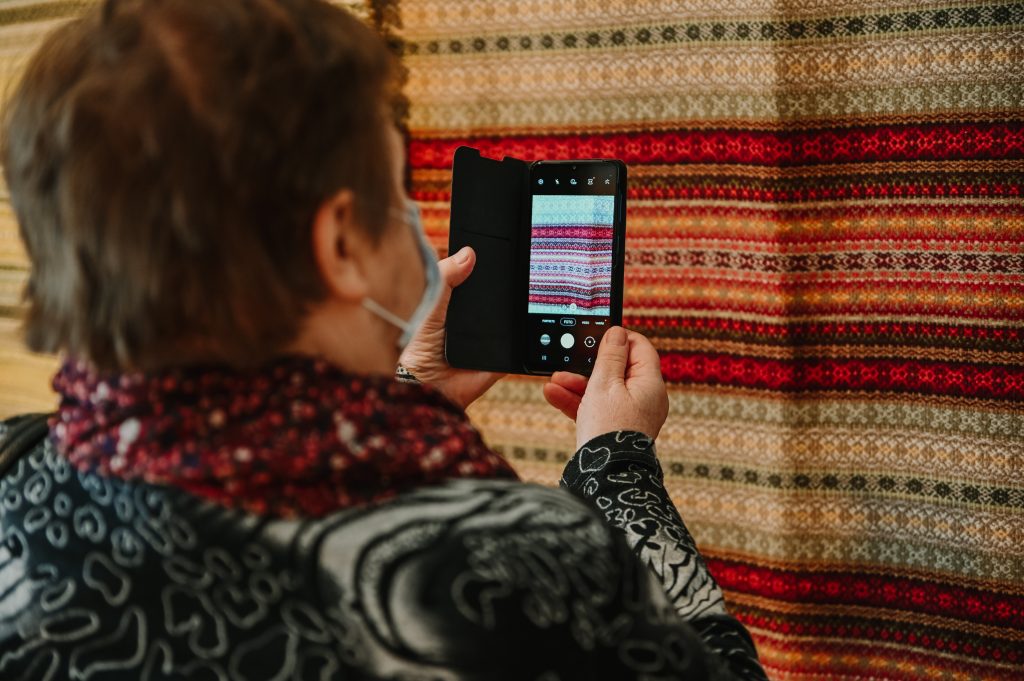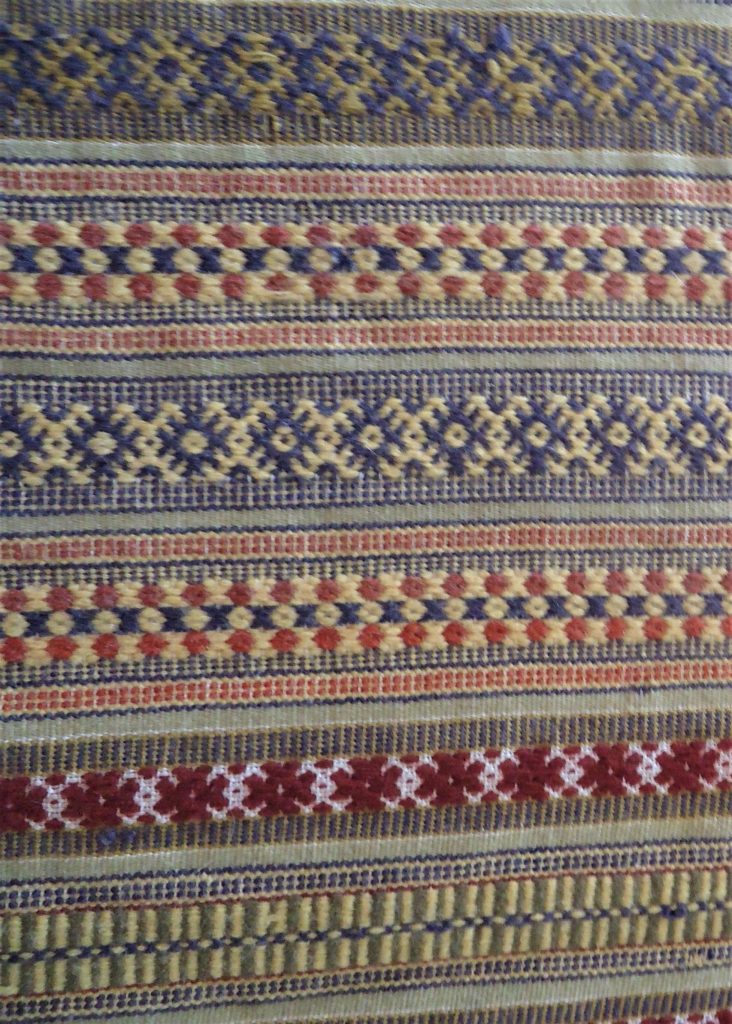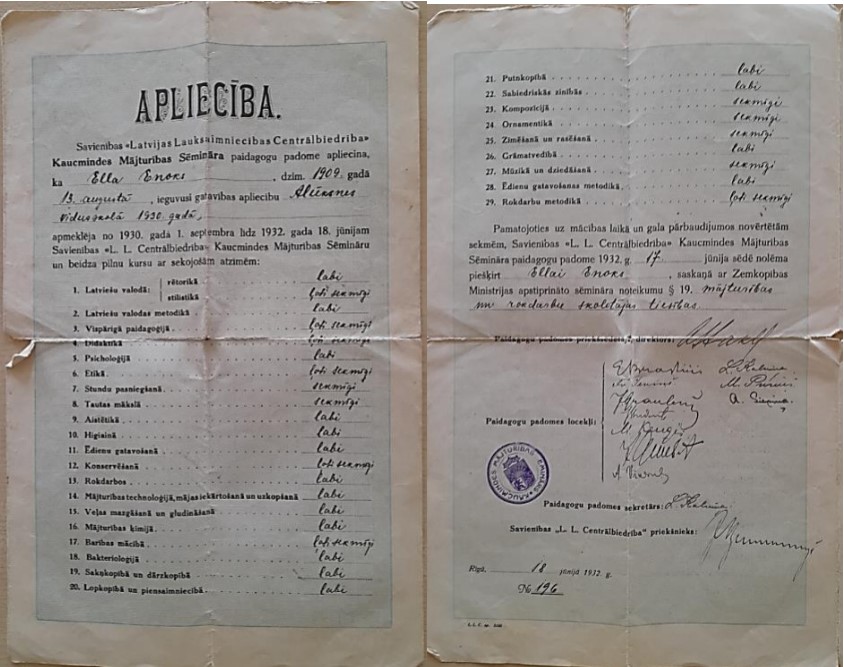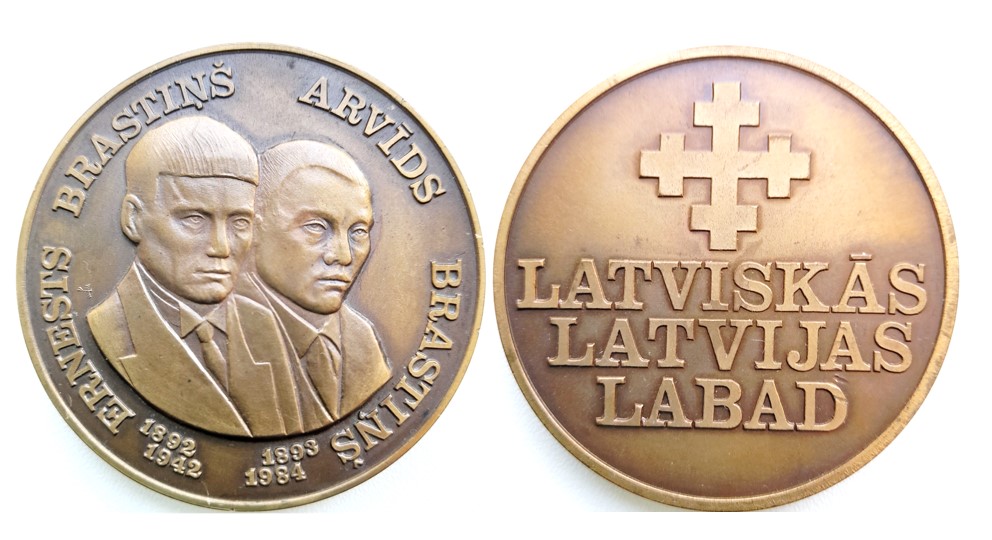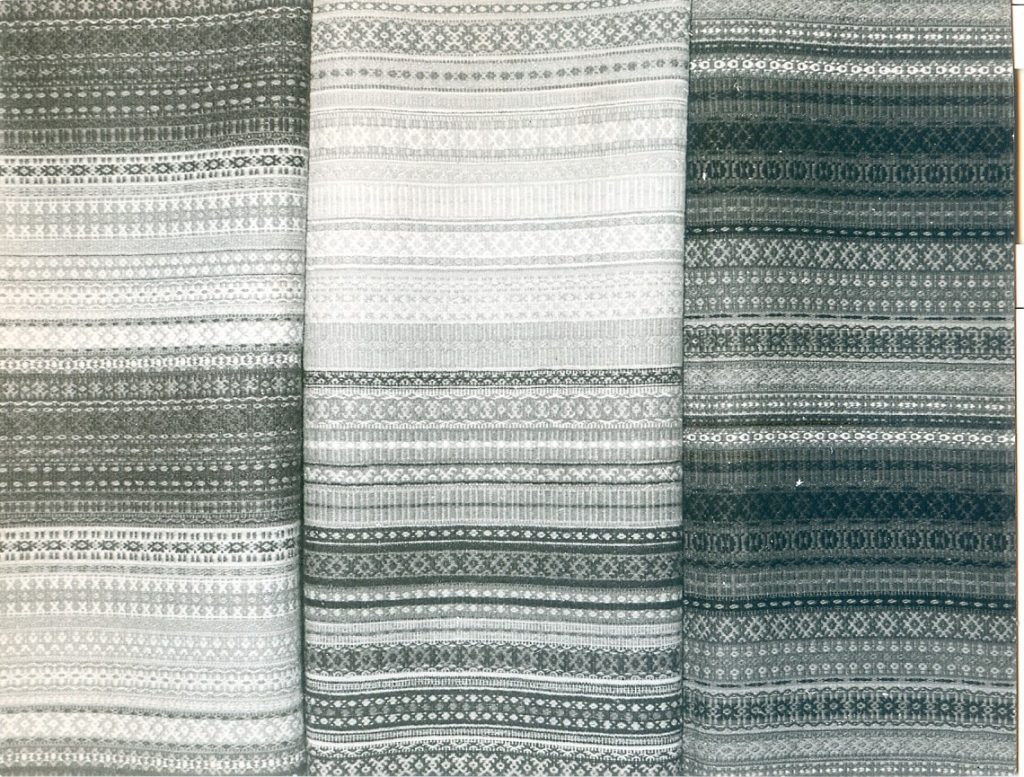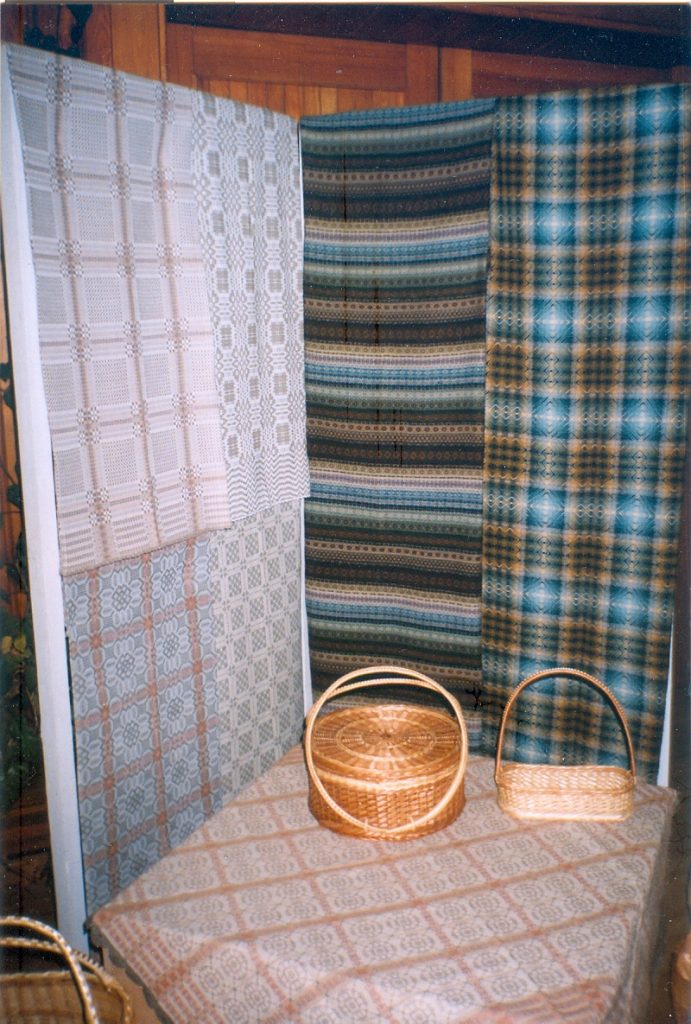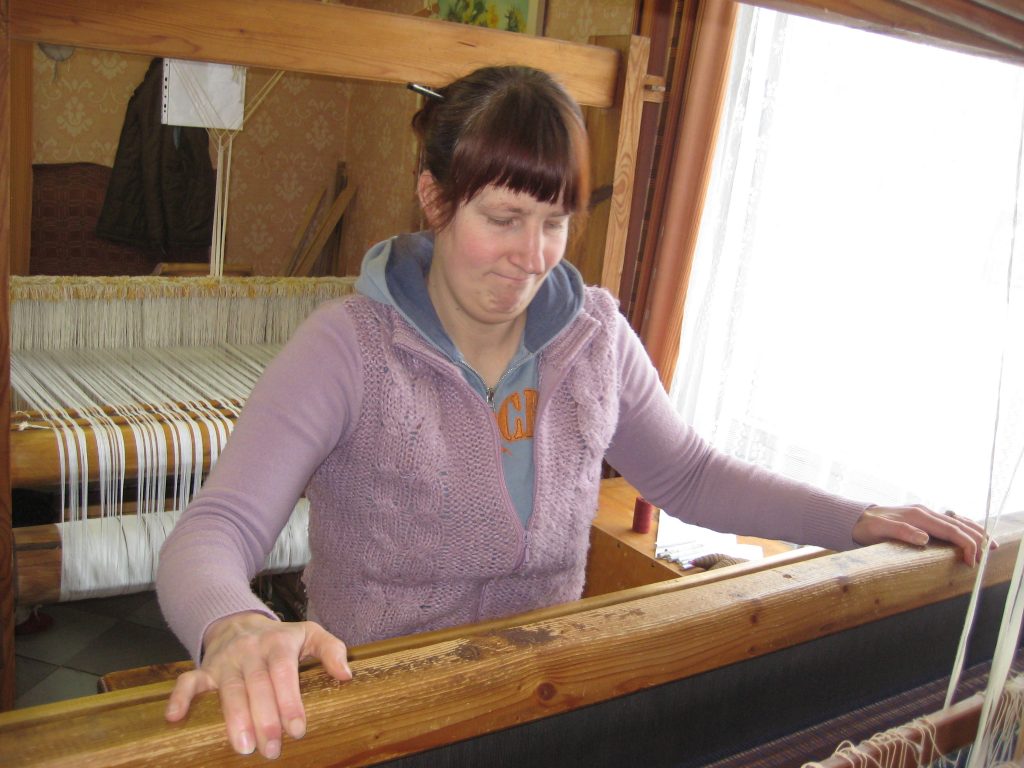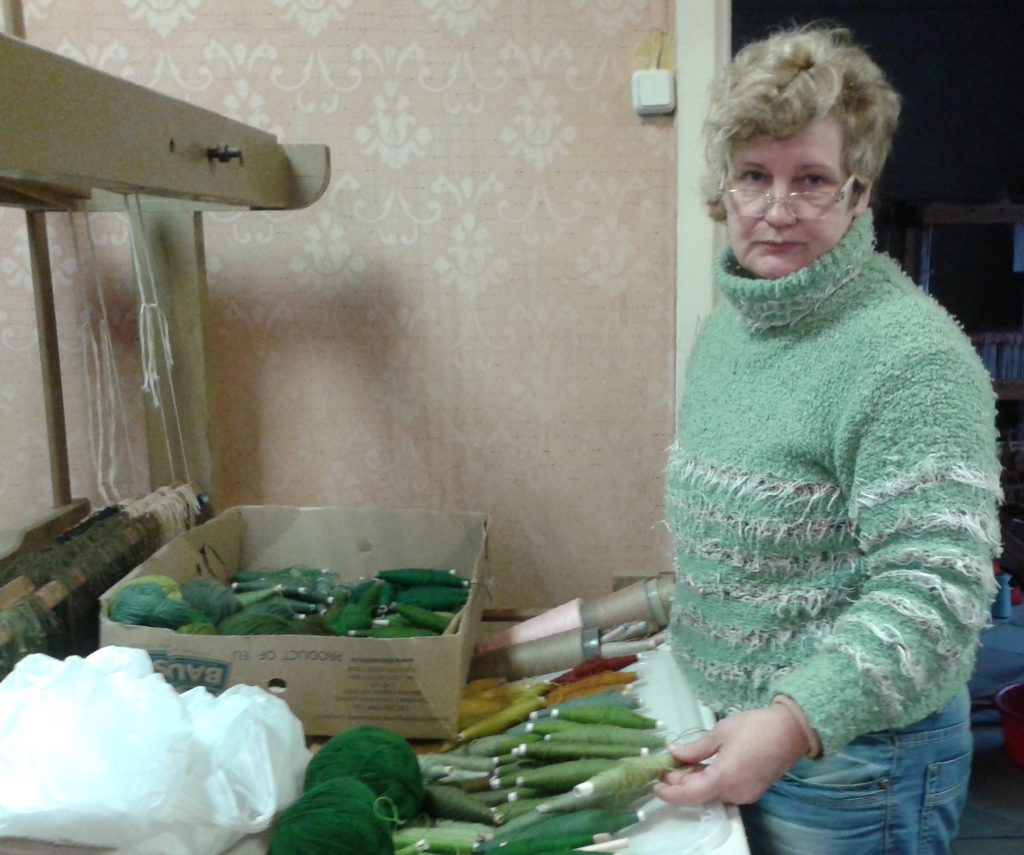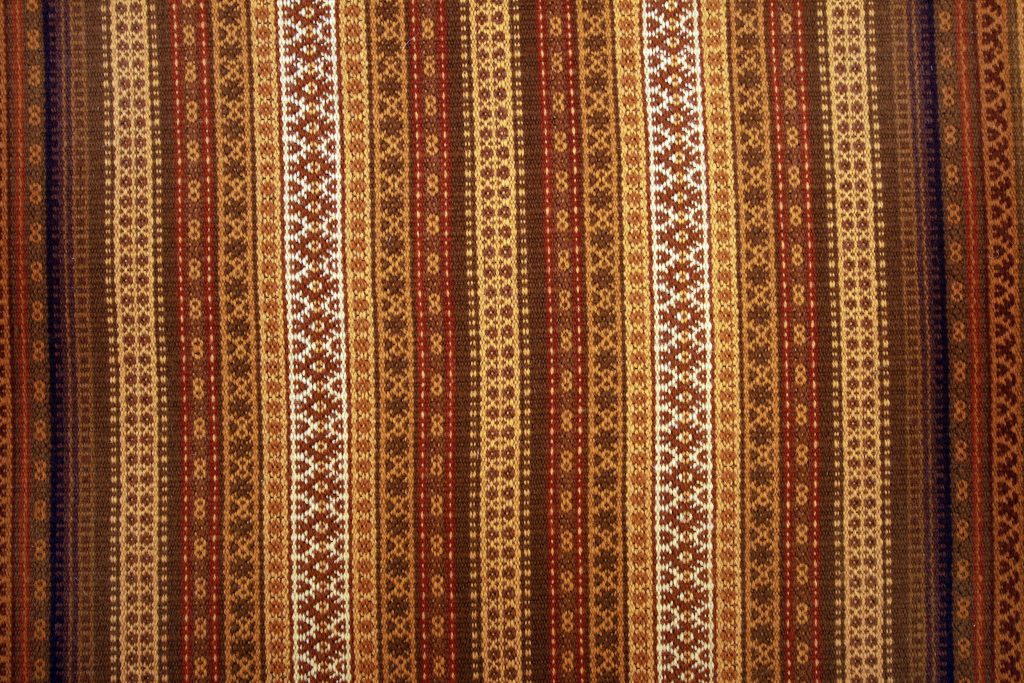Author:
Laila Šteinberga
Traditional craft skills
Title
Band-Patterned Blanket Weaving in the Sigulda Region (2022)
Band-Patterned Blanket
As early as the beginning of the 20th century, band-patterned blankets were known in Latvia as a type of decorative textile, though their weaving involved relatively complex fabric arrangement techniques. In the 1980s, the Folk Applied Arts Studio (FAAS) “Krimulda” developed a simplified technical setup for band-patterned weaving, using 8 shaft layers to allow for a wide range of design possibilities.
Geography
Sigulda Region, Vidzeme, Latvia
In band-patterned blanket weaving, we can identify several groups of interested individuals:
• Weavers-artisans dedicated to continuing the complex and colour-rich tradition of band-patterned blanket weaving. Some of the most active weavers from FAAS “Krimulda” and FAAS “Sigulda” were Masters of Folk Craft (MFC): Velta Steģe, Inta Drozdova, Antoņina Kancāne, Lilija Šica, Ērika Veinberga, Helga Baumane, Helna Millere, and others, who are no longer with us, as well as Māra Polāne, Anda Lārmane, Aina Vilka, who have ceased active weaving. However, Vija Kosarenoka, Laila Šteinberga, Guna Zandberga, Dzintra Ginta, Astrīda Freimane, Anita Pildegoviča, Rasma Rubene, Irēna Balode, Eneri Akmentiņa, and Ludmila Ustinova are eager to share their knowledge and experience in band-patterned blanket weaving;
• New weavers eager to learn and preserve the skills of band-patterned blanket weaving. Weavers have already been identified from several historically significant regions in Vidzeme: Valmiera (FAAS “Mazsalaca” and the Rencēni weaving club), Gulbene (FAAS “Sagša”), Saulkrasti (Saulkrasti weaving group “Kodaļa”), Smiltene (FAAS “Smiltene” and Blome weaving club), Madona (Sarkaņi Craft School), Sigulda (FAAS “Urga”), Jūrmala (Jūrmala weaving group), Limbaži (FAAS “Staicele” and NGO “9 Arodi”), and Cēsis (Vaive weaving club). Members of all of these organisations wish to learn the unique skills of blanket weaving. The search for more interested individuals continues;
• Wearers who, appreciating the significance of Latvian ethnographic patterns, wish to acquire such items to emphasize and preserve their ethnic identity;
• Wearers who have inherited or received band-patterned blankets as gifts and keep them as a tribute to the craftsmanship of weavers from previous generations (including museums).
Significance in community life
Textiles crafted using band-patterned weaving have a wide range of applications—they can be used for interior decor, such as wall hangings, rugs, upholstery, curtains, and throws, as well as for clothing fabric. Most importantly, the creation of decorative textiles that meet modern standards incorporates ancient blanket decoration traditions and composition. Band-patterned blankets reflect the Latvian people’s deep-rooted and centuries-old appreciation for beauty, combined with technical mastery. Depending on the weaver’s sense of colour, weaving experience, and patience, the finished articles can achieve a remarkable diversity in geometric and colourful patterns.
Thanks to an article by V. Steģe in the magazine “Sieviete” (February 1994) and training provided by the Latvian National Centre for Culture (LNCC) for applied arts studio directors, many weavers in Latvia acquired the skills for band-patterned blanket weaving, but intensive production of these decorative blankets primarily took place at FAAS “Krimulda” and FAAS “Sigulda”. A survey of weaving group leaders revealed that only a few skilled band-patterned blanket weavers remain in Latvia, mostly from the older generation and primarily in the Sigulda region. As a result, these blankets are no longer actively produced. Nevertheless, a new generation of weavers has shown interest in learning the craft, emphasising the modern relevance of Latvian patterns to preserve the nation’s intangible heritage and cultural identity.
To preserve the unique value of band-patterned blankets for future generations, the Open-Air Ethnographic Museum of Latvia has purchased two band-patterned blankets from FAAS “Krimulda” artisans (Līga Sausiņa and Laila Šteinberga), while the National History Museum of Latvia has acquired one (by Laila Šteinberga). Many band-patterned blankets, crafted by artisans from the Sigulda region and showcasing the excellence of Latvian folk art, are also preserved in private collections both within Latvia and abroad.
Activities
In the first half of the 20th century, complex weaving techniques were used for band-patterned blanket production, including pattern threading with the help of scales, double-thread setups, a pulling device, or Viļumsons looms with numerous (10–16, or more) shaft layers, making the process labour-intensive. Competition among weavers drove them to seek new ways to create increasingly elaborate fabrics with simpler methods. Most rural households owned looms that could be equipped with 2, 4, or 8 shaft layers, prompting the search for innovations to simplify the process while preserving the diversity of ornament.
The technical simplification of the weaving process was achieved by using a warp-faced rep technique with 8 shaft layers. This method is similar to the well-known “rosepath” with a 4-shaft setup and open-pointed threading. By doubling the shaft-count to 8 and adjusting the treadling sequence, skilled combinations of pattern elements allow for greatly expanded possibilities in the variety of pattern and decoration.
The patterned warp-faced rep is a commonly used weaving technique for striped blankets, allowing both sides of the fabric to be equally functional. This weave has a slightly ridged surface with densely packed weft threads, and its structure is reinforced by mirrored sections of the same pattern. The weave density is high, so warp threads are not visible, with the design created by weft threads woven in contrasting colours. For patterned rep weaves, at least two colours are used, one for the front and another for the back. This results in a matching pattern on both sides, but with reversed colours, similar to the weaving of Auleja-type belts.
The weaving of band-patterned blankets is composed of at least three equally important stages:
1) The technical setup of the fabric base on the looms, where cotton threads are used for the warp and wool yarn for the weft;
2) Combining ornamental bands and coming up with creative patterns using the base design of the fabric. Depending on the order in which the weft threads are woven, it is possible to create ornamental bands of varying widths and configurations;
3) Before weaving begins, a colour design or colour sketch is created. According to this sketch, wool yarn is dyed in various shades using either plant-based or chemical dyes. When planning a colour sketch for band-patterned blankets, the Vidzeme striped blanket composition is often used, with shades arranged in subtle transitions from lighter to darker tones or vice versa, forming repeating and symmetrical pattern sections. Common sources of inspiration for the colour compositions include the Latvian landscape: the blue skies, rivers, and lakes where currents and waves caress grey stones, brown sandstone, the green of linden and oak trees reflecting in the Gauja river, the white blossoms of bird cherry trees in Sigulda, and more.
Passing on and transferring skills
Weaving in Latvia today takes place both individually and collectively. Some artisans have established craft workshops and work professionally, taking their products to market. However, weaving most commonly takes place in applied arts studios or groups led by professionally trained weaving specialists, where enthusiasts work together at an amateur level. Māra’s woven blanket was so unique that other studio participants eagerly embraced the new challenge. Unlike the previously made band-patterned blankets, the weavers from Krimulda combined blankets and sashes using finely shaded yarns with subtle colour transitions, creating a cohesive composition through a harmonious, interconnected rhythm of colour. The main advantage of working with others is the presence of a knowledgeable instructor who can help resolve technical or artistic issues as they arise, enabling participants to share experiences, gain theoretical knowledge, and develop practical skills. Currently, weaving skills in Latvia are taught across 67 studios affiliated with the LNCC.
To recognise, research, preserve, and inspire the younger generation in the skills of creating band-patterned blankets, as well as to foster interest in Latvian decoration and folk art, the following are required:
• provision of practical training for interested individuals;
• organisation of exhibitions;
• promotion of the uniqueness of this craft and the weaving techniques within the community.
To showcase the band-patterned blankets preserved in the private collections of master craftsmen from FAAS “Krimulda” and FAAS “Sigulda”, an exhibition “From the Dowry Chest: Band-Patterned Blankets” (“No pūra lādes. Jostiņsegas”) was held at the Sigulda New Castle from 16 March to 18 April 2022, and continued at the Krimulda Community Centre (22 April to 23 May). A total of 17 blankets were displayed for public viewing, attracting an audience of over a thousand visitors.
History
One of the oldest types of textiles, woven belts and sashes were an essential, and often one of the most luxurious components of Latvian clothing, with their significance changing only in the last century. The first band-patterned blankets were created in the 19th century by sewing together multiple belts and sashes. They quickly gained appreciation from wearers. However, the complex production technique prompted weavers to seek simpler ways to achieve similar results.
The idea of weaving band-patterned blankets using the twill technique at FAAS “Krimulda” emerged in the 1980s, when member Māra Polāne presented an heirloom from her mother Ella Enoks—a woven decorative blanket adorned with decorative bands (see images), which the family used as a piano cover. Ella Enoks had woven this blanket as a ‘masterwork’ or final examination project when graduating from the Kaucminde Home Economics Seminar in 1932. The blanket can be regarded as a family relic that accompanied Ella throughout her exile in distant Siberia and successfully returned to Latvia. Perhaps it was this very blanket and its patterns that preserved Ella’s connection to her homeland, warmed her heart in the cold of Siberia, helped her endure the harsh trials of exile, and inspired her to return home.
Māra’s desire was to continue her mother’s work and encourage other weavers to create something similar. After thorough research on the fabric, FAAS “Krimulda” leader Vija Ābele, together with folk art master Velta Steģe, resolved the technical design of the fabric, allowing the weaving process to begin.
Māra’s woven blanket was so unique that other members of the studio eagerly embraced the new challenge. Unlike previously made band-patterned blankets, the weavers from Krimulda combined blankets and sashes using finely shaded yarns with subtle colour transitions, creating a cohesive composition through a harmonious, interconnected rhythm of colour.
The rise and decline of band-patterned blanket weaving is largely linked to political and economic developments in Latvia.
Starting in the first half of the 20th century, woven blankets were mostly used for decorative purposes, being sewn together to create larger blankets (Aina Alsupe “Audēji Vidzemē”, Riga: Zinatne, 1982).
In the 1920s and 1930s, during Latvia’s first period of independence, there was a strong desire to express a sense of belonging to one’s ethnic group through folk art. This fostered a connection between the prevailing expressions of national romanticism and the exploration of folk antiquity, ethnography, and Latvian decoration. Notable Latvian researchers of decorative elements during this time were the artists Jēkabs Bīne and Ernests Brastiņš. In his book “Latvian Ornamentation” (“Latviešu ornamentika”, Riga: Valodze, 1923), Ernests Brastiņš calls for an awareness of the Latvian decorative elements as an ethnographic heritage from the past.
In the 1980s, towards the end of the Soviet occupation, the representation of Latvian ethnography and decoration in folk art served as a testament to ethnic identity and a quiet protest against the absurd restrictions of the prevailing political regime and Soviet propaganda. In the review “Folk Applied Arts in Soviet Latvia 1970–1985” (“Tautas lietišķā māksla Padomju Latvijā 1970–1985” by A. Alsupe, A. Kargane, Riga: Zinatne, 1988), it is stated: “Traditional band-patterned blankets are very popular. While in the first half of the 20th century they were made with various contrasting patterns, contemporary weavers aim to maintain unified colour tonalities, creating more subtle designs and selecting motifs that adhere to a more cohesive rhythm. As a result, current band-patterned blankets appear more delicate, monotonous, and better suited for small spaces.”
In turn, the 1990s were associated with the national awakening, the restoration of Latvia’s independence, and the public’s enthusiasm for it. This period awakened in people a deeper understanding of Latvian ethnography and ornamental patterns as a value of national identity. During this time, band-patterned blankets also received the highest recognition from society. In 1993, at the XXI Nationwide Latvian Song and XI Dance Festival’s applied arts exhibition, the woven band-patterned blankets by the weavers of FAAS “Krimulda” were awarded the brothers Ernests and Arvīds Brastiņš Memorial Medal.
The new millennium drew back the curtain on the exploration of the cultures of European and global nations, bringing changes to perspectives of community life. Commercialisation took the lead, with the multicultural style and minimalism becoming fashionable, leading to a rejection of ethnic styles that contributed to the decline of band-patterned blanket weaving.
Today, in light of current geopolitical events, there is a renewed interest in Latvian identity and culture. In her book “Patterned Belts: A Shared Cultural Layer” (“Rakstainās jostas: kopīgais kultūrslānis”, Riga: LNCC, 2018), Anete Karlsone highlights the possibilities of belt weaving and notes, “Belt weaving today is not only about creating items belonging to folk costumes. Since the recognition and widespread promotion of Latvian ethnographic heritage in the 1920s and 1930s, they have become a significant reflection of the ornamental richness of cultural heritage.” Therefore, it is now especially important to preserve not only belt weaving but also the craft of weaving band-patterned blankets as a valued part of the intangible cultural heritage.
Masters
The masters skilled in weaving band-patterned blankets using an 8-shaft twill technique: Laila Šteinberga, Dzintra Ginta, Guna Zandberga, Vija Kosarenoka, Eneri Akmentiņa, Ludmila Ustinova, Marija Liniņa (FAAS “Krimulda”) and Anita Pildegoviča, Rasma Rubene, Irēna Balode, Astrīda Freimane, Anda Kalanepa (FAAS “Sigulda”).
Agencies and institutions
• “Smailes” Association;
• Sigulda Municipality;
• FAAS “Krimulda”;
• FAAS “Sigulda”;
• NGO “9Arodi”
Consolidation
To preserve and promote the skills of weaving band-patterned blankets, several significant activities have been carried out.
1. Organised seminars and training:
• In 1993, a training course for leaders of folk applied arts weaving studios in band-patterned blanket weaving was held at the LNCC, under the guidance of Vija Ābele.
• From 8–10 April 2022, during the event “Meet Your Master!” (“Satiec savu meistaru!”) organised by the LNCC, a band-patterned blanket weaving workshop was held under the guidance of masters from FAAS “Krimulda” and FAAS “Sigulda”.
2. Publications in press and media:
• Steģe, V. Band-Patterned Blankets (Jostiņsegas), Sieviete, 1994, No. 2
• Deksne, D. Inherited Beauty, (Pārmantotais skaistums), Praktiskais Latvietis, 2009, No. 23
• Deksne, D. Band-Patterned Blankets (Jostiņsegas), Praktiskie Rokdarbi, 2021, No. 6
• Latvian Blankets for the Latvian Millennium (Latvijas segas Latvijas tūkstošgadei). Riga: Sana Solaris, 2018, 574 pp. (the publication features several band-patterned blankets woven by Latvian artisans using the twill technique)
3. Blankets displayed in various exhibitions:
• 1990 – XX Nationwide Latvian Song and X Dance Festival exhibition
• 1993 – XXI Nationwide Latvian Song and XI Dance Festival exhibition
• 1994 – Riga City Exhibition
• 2002 – FAAS “Krimulda” Exhibition at the Krimulda Civil Parish Community Centre
• 2003 – XXII Nationwide Latvian Song and XII Dance Festival exhibition
• 2008 – XXIV Nationwide Latvian Song and XIV Dance Festival exhibition
• 2009 – FAAS “Krimulda” Exhibition at the Krimulda Civil Parish Community Centre
• 2009 – Exhibition “Jostas, jostiņas, josliņas” at the Latvian Open-Air Ethnographic Museum
• 2016 – “Latvian Regional Blankets” (“Latvijas novadu segas”) national exhibition in Kuldīga
• April 2022 – Exhibition “From the Dowry Chest: Band-Patterned Blankets” (“No pūra lādes. Jostiņsegas”) at Sigulda New Castle
• May 2022 – Exhibition “From the Dowry Chest: Band-Patterned Blankets” (“No pūra lādes. Jostiņsegas”) at the Krimulda Civil Parish Community Centre
In the Vidzeme region (initiated by FAAS “Krimulda”), interested individuals have been identified who wish to learn the skills of weaving band-patterned blankets in the coming years, gradually involving other FAAS and weaving masters in the training process.
The best way to periodically showcase the work of artisans and engage the public is through exhibitions. These exhibitions have attracted a wide audience from both Latvia and abroad, and undoubtedly garnered respect and admiration for the achievements of our masters. Often after the exhibitions, participants expressed interest in joining the FAAS to learn weaving skills and gain knowledge about folk art, as well as wanting to purchase the unique blankets for themselves. Thanks to the publishing of band-patterned blanket weaving techniques in local press publications, weavers were able to access information and experiment with the process themselves. In 1993, the FAAS “Krimulda” association received high recognition at the XXI Nationwide Latvian Song and XI Dance Festival’s folk applied arts exhibition, thanks to their vibrant band-patterned blankets, earning them the brothers Ernests and Arvīds Brastiņš Memorial Medal.
The greatest support and assistance in the development and preservation of weaving skills for band-patterned blankets has come from the state: the LNCC has co-ordinated the activities of weaving groups and folk applied arts associations, organised various textile exhibitions, and partially financed the work of FAAS leaders (targeted grants are provided to motivate artistic group leaders). Additionally, the Sigulda municipality financially supports the activities of FAAS “Krimulda”, FAAS “Sigulda”, FAAS “Vīgrieze”, and FAAS “Urga”, providing facilities, necessary technical equipment, and recruitment of competent instructors. From March 16 to May 22, 2022, the Sigulda Culture Centre held the band-patterned blanket exhibition “From the Dowry Chest: Band-Patterned Blankets” (“No pūra lādes. Jostiņsegas”) at Sigulda New Castle, showcasing 17 band-patterned blankets preserved in private collections. Media involvement is also crucial: for instance, the magazine “Praktiskie rokdarbi” published the weaving methodology for band-patterned blankets in the 6th issue of 2021, sparking interest in the use of this weaving technique.
For the planned development of band-patterned blanket weaving skills over the next five years, see the appendices.
Continuation/development
The participants of FAAS “Krimulda”, in collaboration with weaving masters from other folk applied arts studios in Vidzeme (NGO “9Arodi”) and the Sigulda region, will carry out research within the collections of the Latvian Open-Air Ethnographic Museum, the Latvian National History Museum, and other history and applied arts museums across Latvia with the objective of uncovering the historical development, alternative weaving techniques, and traditions of band-patterned blanket weaving within Latvia and abroad, documenting their findings and producing instructional materials.
To preserve, protect, pass on, and popularise the skills of weaving band-patterned blankets, initiatives will focus on four main areas:
1. Training weaving studio participants through masterclasses.
FAAS “Krimulda” members will regularly organise masterclasses and seminars to attract new weavers. So far, interest in weaving band-patterned blankets has come from weavers across 11 studios in the Vidzeme region, though further outreach is ongoing. With a generational shift occurring in folk applied arts studios, it is particularly important for new participants to gain knowledge of ethnographic ornamentation elements and ways to incorporate it into textiles.
2. Evaluation of training.
FAAS “Krimulda” members, together with the Sigulda municipality and other studios (in collaboration with LNCC), plan to hold a band-patterned blanket exhibition in 2027, where trained weavers will showcase their works.
3. Educating the community, particularly children and young people, in accordance with the values of Latvian folk art, helping them understand ethnographic decorative elements and Latvian colour combinations.
As part of the annual event “Meet Your Master!”, the weavers of FAAS “Krimulda” will present the application of patterned fabric weaving techniques in the creation of woven products.
Participants of FAAS “Krimulda”, together with the Sigulda municipal council preschool educational institutions and art school students, will provide information on Latvian ethnographic decorative elements and their applications in everyday life.
4. Promoting the Latvian decorative element as a code of Latvian identity in the Sigulda region.
In collaboration with the Sigulda Tourism Information Centre and with the support of the local government, a special line of souvenirs dedicated to band-patterned blankets, belts, and Latvian ornamentation elements is planned.
The objectives of the aforementioned measures are:
• to promote an increase in the number of skilled artisans in band-patterned blanket weaving
• to promote the Latvian folk ethnographic decoration both within Latvia and beyond its borders
• to cultivate respect and understanding of Latvian cultural values among young people
• to raise awareness of contemporary ethnic and national identity in response to the challenges of globalisation
Threats
There are several threats to the weaving of band-patterned blankets in Latvia.
1. Lack of weaving masters:
There is a noticeable aging demographic among weaving masters, with few young people interested in acquiring these skills. Globalisation, digitalisation, and commercialisation have shifted societal values, lifestyles, and priorities. As a result, to secure a stable income with a greater profit potential, young people tend to choose more lucrative professions. Furthermore, there are now numerous alternatives for leisure activities, leading to a decline in the number of enthusiasts for folk arts.
2. High product cost:
• expensive looms with 8-shaft setups and equipment necessary for the weaving process;
• expensive materials – cotton threads for warp and dyed wool yarn in various colours for the fabric is required (the cost of materials for one band-patterned blanket can range from €50 to €100);
• time spent on weaving – each blanket is an individual creation and is usually the only example of its kind; the work can take anywhere from two weeks to a month.
3. Low market demand:
This can be attributed to the current consumer culture in society, where buyers opt for cheaper, frequently replaced, mass-produced goods, which, in turn, leads to lower demand and decreases sales in the handicrafts market. By increasing the supply of band-patterned blankets and promoting them as a heritage value characteristic of the Sigulda region and Vidzeme, it is hoped to be able to improve the recognition of these blankets and thereby increase demand.
Applicant
Sigulda Municipality, reg. no. 90000048152, FAAS “Krimulda,” FAAS “Sigulda”
Image Gallery
Audio Materials
Video
Text Materials
Publications
Deksne, D. (2021, No. 6, p. 6,7) "Band-Patterned Blankets ("Jostiņsegas"), "Praktiskie Rokdarbi"
Stege, V. (1994, No. 2, appendix) Band-Patterned Blankets, "Sieviete"
Deksne, D. (2009, No. 23) Inherited Beauty, (Pārmantotais skaistums), "Praktiskais Latvietis"
Websites
“Meet Your Master!” invites you to learn weaving skills; a belt-patterned blanket exhibition is on display until April 17. - An interview with the organisers from the Sigulda Culture Centre of the exhibition "From the Dowry Chest: Band-Patterned Blankets" ("No pūra lādes. Jostiņsegas") at Sigulda New Castle (16.03.–18.04.2022.) – Laila Steinberga and Liga Sausina.

